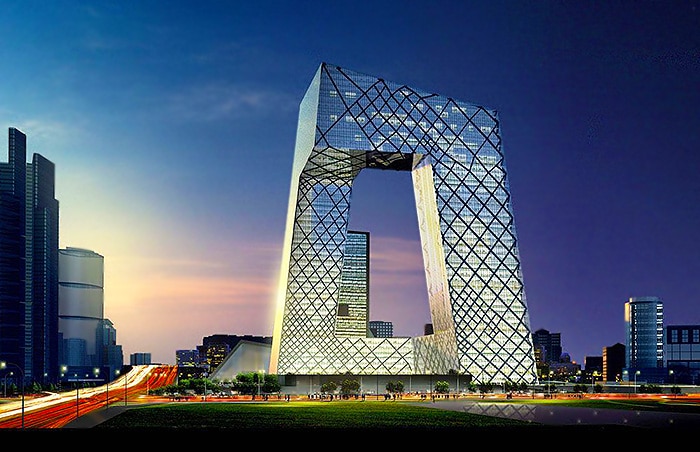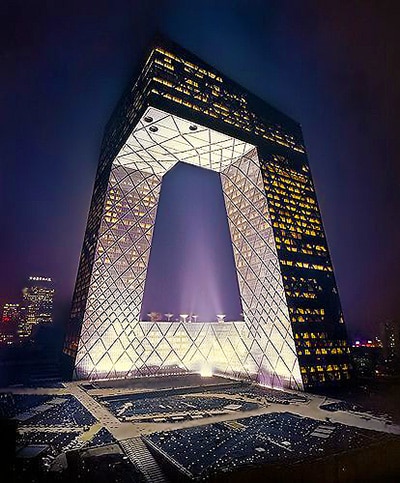Beijing CCTV Building in China: The Future of Asian Architecture
As with my recent post of the North Korean capital’s Ryugyong Hotel or the “Hotel of Doom,” it seems as though Asian countries and their views on architecture are on the rise. Asia has always been at the forefront racing to the top of industrial design, planned efficiency, booming business production, and in making the future the absolute present.
So what is the CCTV building in Beijing China?
The CCTV Building, also known as the CCTV Headquarters or CCTV Tower, is a distinctive architectural landmark located in Beijing, China. It is the headquarters of China Central Television (CCTV), the state television broadcaster of China. The building is renowned for its unique design and is considered one of the most iconic modern architectural structures in the world.
Here are some key points about the CCTV Building:
- Architectural Design: The CCTV Building was designed by the Dutch architectural firm OMA (Office for Metropolitan Architecture), led by the renowned architect Rem Koolhaas. The design was selected through an international competition held in 2002.
- Twisting Form: The building’s design features a striking and unconventional form. It consists of two L-shaped towers that appear to be leaning towards each other and are connected by a 75-meter (246 feet) cantilevered section, creating a dramatic visual effect of two intertwined blocks.
- Functionality: The taller of the two towers, known as CCTV Main Building, is 234 meters (768 feet) tall and primarily houses the television studios and offices for CCTV. The shorter tower, known as the CCTV Annex or TVCC (Television Cultural Center), is 159 meters (522 feet) tall and houses support facilities.
- Structural Innovation: The CCTV Building’s unique form required innovative engineering solutions. To provide stability, a diagonal grid of steel braces was incorporated into the facade, giving it a distinctive visual appearance while serving as a structural support system.
- Public Spaces: The CCTV Building also includes several public spaces, including a public passage through the building at the ground level and an observation deck on the rooftop that offers panoramic views of Beijing.
- Construction: Construction of the CCTV Building began in 2004 and was completed in 2012. The building’s striking design and architectural significance have garnered both praise and criticism over the years.
- Symbolic Meaning: The CCTV Building has become a symbol of modernity and China’s rapid development. It represents the country’s aspirations for technological advancement and architectural innovation.
- Post-Earthquake Renovation: In 2008, the CCTV Building was affected by a major earthquake that struck Sichuan Province in China. The structure was not significantly damaged, but the building’s design was revised to improve its earthquake resistance.
The CCTV Building is a testament to Beijing’s evolving skyline and China’s ambition to create iconic architectural landmarks. Its distinctive form and architectural significance have made it a prominent symbol of contemporary Chinese architecture and urban development.
More about the iconic Chinese CCTV building

Beijing CCTV Building In China At Dusk
We Westerners associate our Eastern counterparts with technological advances, the occasional Harajuku girl (thanks to Gwen Stefani), and where everything is made (in China). However, at the precipice of modern-day architecture, it seems as though Asian architectural structures are leaning towards a common tower of powerfully ominous structural designs.

CCTV Building Beijing China At Night
The Beijing CCTV building which will now host the headquarters of China Central Television has been in the works for the past decade and has undergone some serious scrutinization. Dutch architect, Rem Koolhaas was commissioned in the early 2000’s to create this gateway for Beijing’s center of communication and media. The design of the Beijing CCTV building boasts two 50-story tall tapered legs connected by a 13-story bridge. (Talk about commuting to the office, especially to that corner office.)
For me, the CCTV building is much more than another advancement in the Eastern World. It is more than just a center shrine of Stalinesque inspired design. The CCTV building is a marker, a gateway, into the future of modern-day urban Asian Metropolises.

CCTV Tower Beijing China
There is something to be said about the recent unveiling of building such as the Ryugyong Hotel and the CCTV building, and that voice is coming out loud and clear. During one of my trips to Japan, I was absolutely gobsmacked by the advanced technology just in the airport alone. Japan has always been seen as the pedestal of advancement.
Though, here and now, it seems all of modern-day developed Asia is looking to the horizon and sees past what we, Westerners, are seeing. The CCTV building is yet another milestone for Asian architectural structures. Soon, the Sci-fi world will have a new home amidst the futuristic-inspired land to the east. George Jetson, eat your heart out.
Here are some beautiful Chinese rugs from the Nazmiyal Collection:
If you enjoyed this architecture blog, then you may want to check out: Our Post About The Taipei Performing Arts Center
This architecture blog about the CCTV Building Beijing was published by Nazmiyal antique rugs in New York City.





